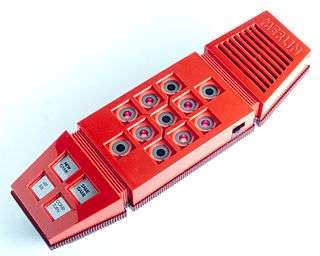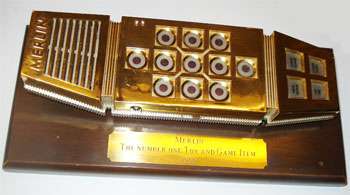Merlin (game)

Merlin (sometimes known as Merlin, the Electronic Wizard) was a handheld electronic game first made by Parker Brothers in 1978. The game was invented by former NASA employee Bob Doyle, his wife Holly, and brother-in-law Wendl Thomis.[1] Merlin is notable as one of the earliest and most popular handheld games, selling over 5 million units during its initial run, as well as one of the most long-lived, remaining popular throughout the 1980s. A version of the game was re-released in 2004 by the Milton Bradley Company.
Merlin took the form of a rectangular device about eight inches long and three inches wide. The play area of the game consisted of a matrix of 11 buttons; each button contained a red LED. The array was encased in a red plastic housing, bearing a slight resemblance to an overgrown touch-tone telephone. Four game-selection and control buttons were also placed at the bottom of the unit; a speaker took up the top section. Supporting electronics (including a simple microprocessor) were contained within the shell of the game. Parker Brothers later released Master Merlin with more games, and the rarer Split Second, where all games involve time with a more advanced display, having line segments around the dots. Both of these share the same general case shape, and came out a few years after Merlin.
Merlin's simple array of buttons and lights supported play of six different games, some of which could be played against the computer or against another person. The games that could be selected were:
- Tic tac toe
- Music machine
- Echo, a game similar to Simon
- Blackjack 13
- Magic square, a pattern game similar to Lights Out
- Mindbender, a game similar to Mastermind
The music machine game functioned as a musical instrument; in this mode each key was assigned a musical note, and sequences of notes could be recorded and played back. This made Merlin one of the earliest digital sequencers as well as an early consumer-level electronic synthesizer.
In 1978 Merlin appeared with Milton Bradley's Simon on the cover of the Christmas issue of Newsweek and the October issue of Boston.[2]
The Toy Manufacturers of America named Merlin the best selling toy and game item (SKU) in America in 1980 (2.2 million sold).

Merlin: The 10th Quest
In 1995, Parker Brothers redesigned Merlin, including making it a one-player game with more challenges called Merlin: the 10th Quest. The premise of Merlin was still the same, but for each game completed, an icon was displayed on the screen showing proof of victory. Instead of the six games from the original, there were nine games:
- Swords & shields, a game like tic-tac-toe
- Seek the Grail, a game like the shell game
- Castle keep, a game of guessing a number between 0 and 99
- Spell bender, a memory-like game
- Mindcaster, played like Mastermind
- Magic Square, played like Lights Out
- Singing sword
- Ghost walk
- Dragon dance
In singing sword, the object is to push the right buttons to make the swords on the screen disappear. Pushing the wrong button will make a sword appear. In ghost walk, directional pads move the ghost towards the center of the screen and destroy it, but the ghost can resist. Dragon dance involves being surrounded in all directions by dragons. If a dragon appears, it is killed by pressing the directional pad where that dragon is. Each of the three last games keep time.
After defeating all nine games, Merlin announces "Brave knight, the challenge awaits" and the 10th quest begins. This involves running through a dungeon maze to escape through the exit. The first round of the dungeon is simple, but the second round shows the walls temporarily before vanishing while the third round has invisible walls.
If the maze is solved in record time, Merlin would say "Congratulations, you are a master" and display the time in the dungeon maze.
References
- ↑ Bob Doyle Bio - Skybuilders.com
- ↑ "The Electronic Wizard". The Electronic Wizard. Archived from the original on 2014-01-06.